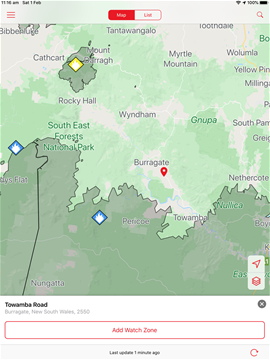 The red mark is Dunblane the dark green is the burning fire
The red mark is Dunblane the dark green is the burning fire
By now we were at high alert. Fires were burning to our north and our south. The Snowy Mountains a few hundred kilometres to our west were also ablaze. Out of control fires had now burnt the whole of NSW east of the Dividing Ranges
from Queensland to 100km north of the Victorian border. Out of control fires had burnt most of East Gippsland in Victoria and had now reached the NSW border, 15 km to our south. We are completely surrounded by national parks and fires were burning out
of control to our south, to our north and to our west. A state of emergency was declared. People began evacuating their properties and seeking shelter in nearby Eden, Merimbula and Bega.
All farmers in our district have a fire plan. One
has to decide if, in the event of a bush fire, you stay to protect your property or you evacuate early. The biggest problem for emergency services is the risk to human life. People, unable to defend their property who fail to leave early, unnecessarily put
their own lives and the lives of the emergency services in jeopardy. The decision to stay and defend needs to be made very carefully. Based on the ferocity of these recent fires, it's obvious that those who choose to stay and defend need considerable
skill and fire fighting equipment. Most farmer are equipped to fight ember attacks. No one I know anticipated the heat and ferocity of the recent fires. We all learnt the meaning of "burning out of control"
Elizabeth and my fire plan was simple. Elizabeth
is asthmatic, so to remain in smoke filled atmosphere is courting disaster. Further, we are both in our seventieth year, and are very aware that even though we are both quite agile and strong, our age is against us. So when word came on 31 December that the
Border Fire was on its way, we hurredly loaded our car with three dogs, one cat, the washing basket with some freshly washed clothes and our passports. We traveled to be with our youngest daughter, Natasha who lives with her husband Andrew and their daughter
Sophie, some 5 hours away, in Young NSW. Of interest, the sky was filled with smoke as far away as Young. We remained in exile, hopping between our children for a full six weeks.
4 January, 2020 was dry and hot. In the late afternoon southerly winds
started gusting around 40km an hour. Perfect conditions to fan the blaze that roared across the state border in a northerly direction. A fire front 50 km wide.
The fuel lying on the ground was so dry that it behaved like a grass fire, racing ahead
of the burning forest creating the intense heat needed to ignite these huge trees. At 3 pm the black smoke turned day into night. Pitch black. 10 kms to the south the roar of the inferno was audible. It sounded like a train racing down the tracks towards you.
The ground began shaking like an earthquake. Petrifying!!! This fire wall raced in a northerly direction at about 6km an hour. Heading directly toward the tiny village of Towamba, located at the southern tip of the Towamba Valley. Everything
in its path way destroyed. Huge heavy steel vehicles used by the forestry people literally melted where they were parked. Miraculously, as this fire reached the edge of Towamba village, the wind dropped and the relentless advance stopped.